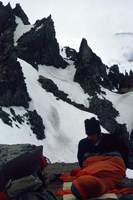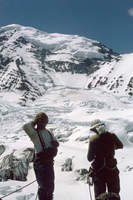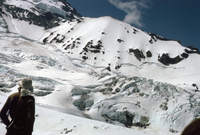Ptarmigan Ridge, Mount Rainier
– Bruce Carson Memoriam –
May, 1972
Seattle to Summit to Seattle in Under 48 Hours
The Ptarmigan Ridge route is one of
Fred Beckey's
100 Favorite North American Climbs
and is also described in
Selected Climbs in the Cascades v2.
Ptarmigan Ridge is rated as Grade IV on a scale from I to VI.
This makes it one of the most challenging routes on Mount Rainier.
Good route descriptions,
pictures and climb maps/profiles can be found
here
and
here.
Spring,
2010:
I retired from climbing long ago and now get my thrills by reading books
about climbing.
Reading
The Boardman Tasker Omnibus,
in which the authors made admiring references to Bruce Carson's
exploits,
prompted me to go back to my journals from long ago to re-live some of
my encounters with him.
In my notes,
he is almost exclusively referred to as
“Carson.”
Perhaps it seemed like a more apt name than
“Bruce,”
but it was more likely out of respect.
Even at the early stage of his career I knew him and though he was at
the time several years my junior in age,
I considered him to be several cuts above me in the climbing world.
The most interesting encounter is described a letter I wrote to a friend
concerning a climb of Ptarmigan Ridge,
with editorial additions in italics:
One weekend I was planning to climb with Tom,
my room-mate and frequent climbing partner,
but he announced Friday evening he would not be going.
That left me without a partner and more than a little pissed.
I immediately called Bruce Carson and learned he was preparing to
leave for a climb of Ptarmigan Ridge.
Without hesitation,
he invited me along.
Tom and I had planned to climb Ptarmigan Ridge in the near future,
so I thought this would be just deserts for him.
When Tom found out the plan,
he was sure we would not make it because it was too early in the season
and we did not have enough time
(having to be back Monday morning).
I came to know Carson from taking the University of Washington climbing
courses,
where he frequently acted as assistant instructor;
I forget which course it was I met him.

Two possible reasons that Carson was happy to have me along
(other than the fact that he is such a nice guy)
were that I had a more reliable car and he was climbing with a novice by
the name of Dan,
who had just finished the beginner course with a climb up Mount Baker,
so he appreciated the chance to have another experienced hand along.
We left Seattle at 9PM,
woke up the ranger at midnight
(he was not happy)
to register for the climb,
and started hiking at 12:30AM.
This early in the season approaches are snowed in,
so we had to go via the White River Campground.
Even the White River Campground road was snowed in,
adding 2 miles and 400 feet vertical to our travel.
By sunrise we were at Saint Elmo Pass,
where we took a short rest.
It started to rain,
so we napped with our sleeping bags inside our
cagoules
for about 3 hours.

After our rest stop the weather still looked menacing,
but we continued on,
traversing about ¼
of the way around the mountain in soft snow at an altitude of 7,000 to
7,500 feet.
As we continued,
the weather cleared.
In this picture we are at about 7,000 feet.
Brice Carson is facing the mountain.
Liberty Ridge is at the left and Ptarmigan Ridge is at right.
The technical route begins on the other side of the ridge,
but one can start to make out some features of the upper portion of the
route from here.
On our climb of Liberty Ridge,
Bob Sloan and I camped
near here
at the end of the first day of a three day climb of Liberty Ridge.

This next picture is looking a bit to the right from the previous one.
We have to traverse the heavily crevassed Carbon Glacier to the ridge at
the extreme right of the picture.
Our
“base camp”
is still a couple of miles and over 3,000 feet elevation gain away,
and we have to be home tomorrow!
While climbing Rainier from Seattle and returning in under 48 hours
might seem
“better than average,”
note that we had to hike extra miles between the car and trailhead,
then traverse almost ¼
of the way around the mountain on glaciers at about 7,000 feet.
Most climbers avoid this long glacier traverse by approaching from
Mowich Lake directly up the Carbon Glacier,
but the road for that approach was snowed in.
Once we attained the base of the ridge we headed up to about 10,300 feet
to make camp at 6:30PM Saturday.
We were beat!
We each prepared and ate our individual dinners while studying the route
we would climb in the wee hours of the next day.
We were above the clouds,
so laid out our bags on top of our cagoules and slept well.
We were so tired we overslept,
waking at 3AM and leaving at 4AM.
The first 1,000 feet suggested to me what Willis Wall might be like:
steep snow slopes alternating with near-vertical rotten rock cliffs and
an ice cliff hanging over us far above.
Because of the late start,
we agreed there was no time to use protection or belay;
we went unroped because without these precautions the rope was a suicide
pact.

Conditions were perfect;
we cramponed up the snow slopes and found steep little fingers of snow
to get past each cliff.
I was in the lead when we came to a steep
“apron”
of
water ice
about 20 feet across.
I started across,
but noted that one slip would yield a quick trip to the glacier
thousands of feet
(well, much more than one thousand feet)
below with no chance of arrest.
I turned to Carson and told him I wanted a belay.
He said it was too awkward to rope up here,
so I stepped aside and said
“After you,”
thinking he might reconsider.
This did not change his mind;
he pulled out his ice hammer and side-stepped across on his crampon
front points using ice axe and hammer for additional support.
I followed in the same manner.
When climbing steep ice,
one tries to maintain an erect position rather than
“hug”
the ice;
in this position,
it was thrilling to look down between my feet and see the glacier far below.
I could not watch as Dan came across because I did not want to see the
novice fall to his death.
But he made it.
In addition to being water ice,
the
“apron”
was clearly a place where water,
snow and rocks funnel down from far above.
Since the sun was starting to make its appearance,
the apron and the route above it are not a place to dally.
Shortly after the ice apron traverse,
we came to a section of rotten rock.
It was Class 4
(class is the difficulty of short sections and is rated from 1 to 5.9),
but so rotten we were afraid of large rocks coming loose.
A fall meant serious injury IF one managed to keep from falling all the
way to the glacier.
This time I convinced Carson to belay because the rock was less
predictable than the ice
(cf.
Kautz Glacier).
He was reluctant,
but agreed after I found a crack and wedged a stone into it with a sling
around to use for protection.
I tried to make myself as stable as possible to catch a fall.
Carson went first,
with me belaying.
With Carson's assent,
I did not tie the rope to myself during the belay;
if he was trapped in heavy rockfall and the belay could not be held the
rope would be lost with him rather than pulling me along.
He made it across without incident.
Then Dan went
(with belays fore and aft)
and I followed.
The
“rotten traverse”
got us around the ice cliffs.
From that point on was steep glacier stomping to the Liberty Cap summit.
The accompanying composite picture was taken from our base camp at about
10,300 feet.
The summit is 4,000 feet above.
The red line approximates the route we took.
I believe Carson led us up from the ice apron traverse
(marked with an X)
then left to the rotten rock traverse
(marked with an R).
This is known as Variation 1 or the Ice Cliff Variation of the route and
avoids the difficulties we would encounter had we gone right up the
rotten gully to the Rock Chimney Variation.
It is questionable Dan would have been up to the latter alternative.
I do not recall the exact route we took after the rotten traverse,
only that after a few difficulties it was easy compared to what came
before.
Some excellent pictures and route details can be found
here.
After the rotten traverse we were roped up in case of crevasses in the glacier;
Carson was in the lead,
Dan in the middle and me bringing up the rear.
All along,
Dan had been telling us about the conditioning program he undertakes,
consisting almost exclusively of weight training.
Meanwhile,
Carson and I were trying to out-do each other with claims of being out
of shape.
Dan ran out of steam and was unable to keep up with us,
so Carson took Dan's pack,
strapped it onto his own and carried two packs the last 1,500 vertical
feet to the summit.
We still had to keep a slow pace to accommodate Dan.
He resolved to undertake aerobic training in the future.
We reached Liberty Cap around 11AM and immediately started down the
Emmons Glacier,
taking a leisurely pace in deference to Dan.
As we descended below 10,000 feet,
Dan's energy returned and we picked up the pace.
Below 7,000 feet we all felt the effects of more oxygen;
when we unroped,
Dan insisted on carrying the rope.
We literally ran the last several miles through the snow back to the
car,
managing to shed clothing and stuff it into our packs without stopping.
We got to the car at 4:30PM and arrived back in Seattle at 7:30PM
Sunday.
Carson said the only more strenuous climb he had done was a winter
ascent of the
Nisqually Ice Fall.
I'm sure many of his subsequent climbs were much more grueling but,
considering we had little sleep in the 60 hours since Friday morning and
had done what is usually a 3-day climb in under 2 days,
it was definitely the most strenuous climb I had done.
When I walked into our apartment back in Seattle,
Tom laughed and said he had talked to several friends and all agreed we
wouldn't make it.
He said I looked too fresh
(the effects of sea-level oxygen and a successful summit, perhaps)
and was back too early to have made it.
I told him I would show him the pictures when they were developed.
Technically speaking,
the climb was disappointingly easy —
other than the ice apron and rotten traverse!
I think this was in part due to the excellent conditions and in part due
to the early season providing substantial snow to cover what would
otherwise have been more difficult and dangerous climbing.
Another factor was that Carson was a very good route finder;
I doubt I would have been able to do as good a job as he did.
— end of letter —
There were a number of other occasions I either climbed with Carson or
met him while climbing.
For example,
at the
summit of Rainier
and
a winter attempt on Rainier.
Not long after this climb I was flattered to be invited by him to go to
Yosemite and try wall climbing.
I declined,
partly because I feared I could not climb up to his standard,
but also because I had almost been kicked out of grad school for
spending too much time climbing.
By this time,
I was close to finishing my PhD and I held that to be more important.
I completed my PhD and moved to Colorado in Fall of 1972.
At the time there was a movement to get more young climbers involved in
big expeditions,
and Carson was an obvious candidate.
Meanwhile,
I focused more on my academic career and less on mountains.
Years later,
I heard Carson had died on a climb of Trisul in the Himalaya in Fall 1975,
aged 24.
On that climb,
he was true to form,
always doing more than his share and going further than the others.
I was saddened to hear of his death;
he was an excellent climber and,
more importantly,
a fine person to know.
Over the short span of his career,
Carson made a mark in the climbing world,
influencing many great climbers.
One can find some of his exploits with clever Google searches;
for example:
Index Town Wall and the Nose in Yosemite
describes how he pioneered the art of
“clean climbing.”
Climbing routes have been
named in his honor.
Royal Robbins
wrote a
Memoriam
for the
American Alpine Journal.
He is mentioned many times in Arlene Blum's
Breaking Trail: A Climbing Life;
a
picture album from her book
is available on
her website.



